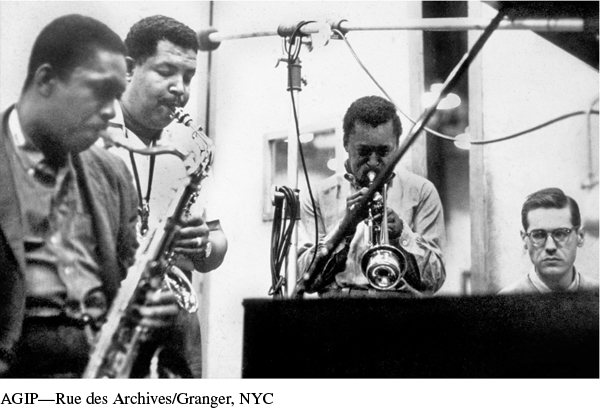Beats and Other Nonconformists
As many Americans migrated to the suburbs, spent money on leisure and entertainment, and cultivated religion, a small group of young poets, writers, intellectuals, musicians, and artists attacked mainstream politics and culture. Known as Beats (derived from “beaten down”), they offered stinging critiques of what they considered the sterility and conformity of white middle-class society. In 1956 Allen Ginsberg began his epic poem Howl (1956) with the line “I saw the best minds of my generation destroyed by madness, starving hysterical naked.” In his novel On the Road (1957), Jack Kerouac praised the individual who pursued authentic experiences and mind-expanding consciousness through drugs, sexual experimentation, and living in the moment. At a time when whiteness was not just a skin color but a standard of beauty and virtue, the Beats and authors such as Norman Mailer looked to African Americans as cultural icons, embracing the spontaneity and coolness they attributed to inner-city blacks. The Beats formed their own artistic enclaves in New York City’s Greenwich Village and San Francisco’s North Beach and Haight-Ashbury districts.
The Beat writers frequently read their poems and prose to the rhythms of jazz, reflecting both their affinity with African American culture and the innovative explorations taking place in music. From the big bands of the 1930s and 1940s, postwar jazz musicians formed smaller trios, quartets, and quintets and experimented with sounds more suitable for serious listening than for dancing. The bebop rhythms of trumpeter Dizzy Gillespie and alto saxophonist Charlie Parker revolutionized jazz, as did trumpeter Miles Davis and tenor saxophonist John Coltrane, who experimented with more complex and textured forms of this music and took it to new heights. Like rock ’n’ roll musicians, these black artists broke down racial barriers as their music attracted white audiences.

Homosexuals also attempted to live nonconformist lifestyles, albeit clandestinely. According to studies by researcher Dr. Alfred Kinsey of Indiana University, homosexuals made up approximately 10 percent of the adult population. During World War II, gay men and lesbians had the opportunity to meet other homosexuals in the military and in venues that attracted gay soldiers. Though homosexuality remained taboo and public displays of same-sex sexuality were criminalized, politically radical gay men organized against homophobia after the war. In 1951 they formed the Mattachine Society in Los Angeles, which then spread to the East Coast. In 1954 a group of lesbians founded the Daughters of Bilitis in San Francisco. Because of police harassment, most homosexuals refused to reveal their sexual orientation, which made sense practically but reduced their ability to counter anti-homosexual discrimination.
Kinsey also shattered myths about conformity among heterosexuals. In Sexual Behavior in the Human Female (1953), he revealed that 50 percent of the women he interviewed had had sexual intercourse before marriage, and 25 percent had had extramarital affairs. Kinsey’s findings were supported by other data. Between 1940 and 1960, the frequency of out-of-wedlock births among all women rose from 7.1 newborns to 21.6 newborns per thousand women of childbearing age. The sexual relations that Grace Metalious depicted in Peyton Place merely reflected what many Americans practiced but did not talk about. The brewing sexual revolution went public in 1953 with the publication of Playboy magazine, founded by Hugh Hefner. Through a combination of serious articles and photographs of nude women, the magazine provided its chiefly male readers with a guide to pursuing sexual pleasure and a sophisticated lifestyle.
Like Metalious, many writers denounced the conformity and shallowness they found in suburban America. Novelist Sloan Wilson wrote about the alienating experience of suburban life in The Man in the Gray Flannel Suit (1955). In J. D. Salinger’s novel Catcher in the Rye (1951), the young protagonist, Holden Caulfield, mocks the phoniness of the adult world while ending up in a mental institution. Journalists and scholars joined in the criticism. Such critics often overstated the conformity that characterized the suburbs by minimizing the ethnic, religious, and political diversity of their residents. Yet they tapped into a growing feeling, especially among a new generation of young people, of the dangers of a mass culture based on standardization, compliance, and bureaucratization.
REVIEW & RELATE
What trends in American popular culture did the television shows and popular music of the 1950s reflect?
How did artists, writers, and social critics challenge the mainstream politics and culture of the 1950s?
Exploring American HistoriesPrinted Page 837
Exploring American Histories Value EditionPrinted Page 618
Chapter Timeline